[
homepage
|
subscriptions
|
feedback
|
guestbook
|
contents
]
FLASH OF GENIUS
story and photographs by Martin Richardson
Bach was where they met. And when the passion of a classical cellist
encountered the superb control of kabuki, something extraordinary was bound to
happen

Yo-Yo Ma could have stayed home. He could have been sitting in front of the
fire polishing his six Grammy awards, basking in the accolades which have
compared his cello playing to that of famed virtuoso Mstislav Rostropovich. He
could have been adding to his prolific recording repertoire, which now includes
virtually every major composition for cello. He could, in short, have been
content in the knowledge that he is a superstar--possibly the most gifted
cellist of his generation.
But no. Yo-Yo Ma had to have a vision.
Bach for all. On film. A document of the struggle involved in artistic
collaboration and the creative process leading to a performance. A
demystifying guide for the masses.
Which is why in June of last year Ma was in Tokyo with Tamasaburo Bando, the
leading proponent of the age-old rituals of kabuki, discussing the intricacies
of Bach Suite No. 5.
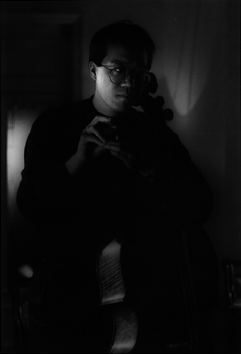
Ma had chosen Tamasaburo as one of six artists from different disciplines
with
whom he would collaborate in a film series, Inspired by Bach. They
would create, as producer-director Niv Fichman says, "a suite of films; a giant
Bach Suite of six hour-long films." Fichman, who also produced the critically
acclaimed "Thirty-two Short Films About Glenn Gould," saw it as an irresistible
challenge. "I had a fascination . . . with the Japanese aesthetic, so I
immediately grabbed that [Suite to direct] for myself."
Ma's other subjects for collaboration hailed from the past and the present,
both animate and inanimate. One film segment would place Ma in a "virtual
reality" setting based on renderings of never constructed buildings by the
18th-century Italian architect Giovanni Battista Piranesi. Another two-year
project was to follow the process of making an urban "refuge," a garden in the
center of Boston, inspired by Suite No. 1, where buskers and music
students from the nearby conservatory would play. Not all Ma's overtures were
as successful. After he penned an impassioned letter to director Jane Campion,
he received a curt, two-line note from her agent: "Ms. Campion does not do TV."
But Ma was unperturbed. By June of 1994, he had already finished shooting the
Third Suite with dancer-choreographer Mark Morris, and he and Fichman were to
arrive in Tokyo for the fifth suite production.

Fichman had decided to travel light, with no crew except Joost Dankelman, his
director of photography. It was the cinematographer's equivalent to a voyage
with a toothbrush and a change of undies: no burden from the baggage, but not
much protection if it rains, either.
And rain it did. As the humidity foretold the inevitable June downpours, so
ominous clouds gathered over the project itself. The schedule, however,
had seemed reassuring in its black and white chronology of eight 12-hour days;
in its blueprints of sets to construct. The Four Seasons Hotel was booked for
documentary sequences as was a large Tokyo film studio for the actual
performance. A whole crew was on standby.
But schedules don't have artistic temperaments. Kabuki superstars do. As
the
central character of the sycophantic world of kabuki, Tamasaburo was not
accustomed to playing second fiddle. His own directorial debut was set to
commence the very day after the shoot, and he had more than a few ideas he
wished to share on the subject of film-making. "Tamasaburo was used to shaping
his own work," says Fichman. "He felt that it was spinning out of control with
the deadlines for shooting, and he wanted his creative input." The stand-off
resulted in a stand-down and Ma had his collaborative struggle--though perhaps
not in the form he envisioned.

Just in from Boston, Ma leapt straight into shuttle diplomacy between
Tamasaburo's Chiba residence and the production base at the Four Seasons.
Tamasaburo was eventually swayed by Ma's demonstration of earnestness and a
compromise was reached: the documentary sequences in which they were to discuss
the melding of their disparate artistic visions would be shot in June. The
performance itself was rescheduled for November. "That's the whole idea of
collaboration," says Ma. "As much as you strive to reach some degree of
height, you know that you may sink. Ultimately we are dealing with the idea of
trust between people."
Shooting began five days later, but the hiatus had created a backlog of footage
to be shot and the result was an increased air of tension. The lighting
director swore at his assistants, and the famed unflappability of Dankelman was
tested to the limit as Tamasaburo insisted on filter previews for his skin
tone.
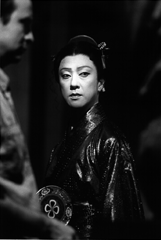
The problems were resolved on the second day of shooting, at the Kabuki-za.
The venerable theater was looking its best, bathed in warm film and stage
lights, and Tamasaburo justifiably felt at home as he talked the camera through
his early life as a performer. Ma listened enraptured until, suddenly, he
reached into his pocket and produced a full collector's set of Tamasaburo
telephone cards. "Just look at these," he blurted. "You're a huge star here.
You're bigger than Madonna." Tamasaburo let out a howl and playfully lunged
for the cards. The tension lessened, and the shooting continued successfully.
"Tamasaburo demonstrated [that day]," says Fichman, "that he was totally on
board."
There were yet other obstacles to overcome. On the set at the Four Seasons
the next day, Tamasaburo, for all his mastery of his own medium, appeared
baffled by the dictates of the Western form he was striving to interpret. Ma
played motifs from the Allemande movement of the suite as they talked,
and the kabuki dancer interpreted the notes with movement. Bach does have a
beat, he discovered, but for one with an intuitive feel for the emotion, the
beat was in the way.
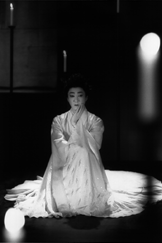
In his loose-fitting black civvies and minimal make-up, Tamasaburo appeared
vaguely vulnerable. It was clear that he had made a leap of faith and had come
prepared to show an unprepared artistic nakedness. But now the artistic
struggle had begun. Ma played, watched with his patented look of intense
concentration, listened, reinterpreted. The two stood, sat again and agonized
as the film rolled. The revelation for Tamasaburo was learning to express the
emotion of the piece with the upper part of the body while maintaining the
pulse with the lower. Ma immediately felt Tamasaburo's movement through his
bow. The moment was the "root of inspiration, the root of creativity" that he
sought for himself, the dancer and the audience. Tamasaburo was "inside the
work."
"I can feel the rhythm in the base of my neck," Tamasaburo exulted. "For me,
the pulse is inevitable, it is fate," Ma said, making exaggerated circles of
the bow to accentuate the persistence of Bach's rhythm. By this stage even the
tone-deaf lighting technician had developed an involuntary foot-tapping motion.
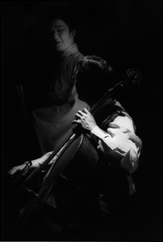
"That was quite a eureka moment," says director Fichman. "As a documentary
film maker you seldom get to see the inner workings of the mind like that,
because no one particularly enjoys showing themselves struggling."
Valuable footage was in the can and the mood was upbeat as the two parted,
with the performance shooting slated for November. On the night of the wrap
party, however, Ma sent apologies. The discreet chrysanthemum markings on the
limousine that picked him up outside the hotel hinted at a slightly more
exclusive venue. Tamasaburo was also absent, off working on his own film.
If we ever evolve into a classical MTV culture, Ma will be its undisputed host.
He is personable, articulate, with boyishly handsome looks. Classical music
needs a face-lift and Yo-Yo Ma has the face.
His talent is unquestioned. At the age of five, he was able to perform three
of the Bach suites for solo cello at a public recital; his father, himself an
accomplished violinist, had taught him two measures a day.
They were the first actual pieces Ma played and the last his father heard.
"My father actually survived spiritually during the war by playing that music,"
says the cellist. "I think that connection was passed on to me." And though
his father was a man not given to verbal expression, "we communicated through
music; and that remains very precious to me."
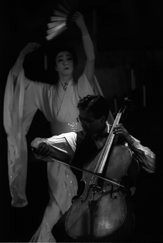
He found himself once again in Tokyo in November, with the same crew, the
same
collaborator and a need to communicate. The setting was far from plush. The
walls were gray and peeling, the surfaces worn. The synthetic reality served
as a foil for Tamasaburo's kimono-clad entrance onto the set of cavernous
Studio 13.
He was a man transformed. He was a woman down to a toe, gliding around with
full kabuki make-up and an exquisitely choreographed air of disregard as he
settled by Ma's side. "Yes," he purred with feminine pride. "I'm
beautiful."
It was Tamasaburo's world. "What he does, perhaps, is out of synch with
modern society," explains Ma. "He devotes his life to the spark of life in a
performance."
The stage flickered under the glow of the light from hundreds of candles.
Warmly lit screens hung in geometric patterns, evoking the vertical and
horizontal shapes prevalent in kabuki. Tamasaburo softly padded to the edge of
the stage, where he was enveloped by his entourage of eight, each trained to
anticipate a Bando whim at 50 paces. He remained demurely in character as his
shoulders and creative ego received a tender massage.
Ma prepared oranges for the flagging crew and ensured that each member had a
bite. The second assistant to the assistant who held the clamps was more
accustomed to receiving abuse than gestures of kindness from celebrities and
meekly smiled his gratitude. For Ma, the humanistic intent applies in equal
measure to life and art. "I call Ma the reluctant genius," says Richard
Kipnis, producer, Japan. "Tamasaburo, dare I say, has airs to his genius."
One moment our reluctant genius was lying on his back joking with the
interpreter, or strumming the Pink Panther theme on his 1712 Stradivarius; the
next playing like a man possessed by Bach's very spirit.
Roll camera. Action. The notes rose and Tamasaburo uncoiled. Soon the
discussions, the interviews, the "hemming and hawing," as Ma put it, made sense
in the collaborative performance. Forgotten were Tamasaburo's troubled musings
on the Bach pulse: for the rhythmic Gavotte movement, he actually made a
virtue of the beat by wearing a drum and striking it with unbridled glee. In
the poignant Sarabande, the kabuki master was at his tragic best. Then,
in the Courante he was a whirl of movement, snapping with his fan before
finishing "with a flash in his eyes," Ma recalls. "That was frightening, as it
should be. That was an amazingly dramatic moment."
But perhaps the crowning moment of the performance came during the
Gavotte, when Tamasaburo tenderly lifted the cello from Ma, fading to a
haze behind a screen, prizing his treasure.

"That was goosebump material," says Ma. "It was a very spiritual moment. By
taking away the instrument--which is my voice--he established contact with that
part of me."
For whatever reluctance Tamasaburo has displayed, for all the controlled
obsession which appears to be an occupational hazard of kabuki stardom, in the
performance, where it counts for him most, he displayed a touchingly selfless
desire for intimacy with Ma's world. "Tamasaburo has become the dream where he
hopes Yo-Yo's father will be," says Kipnis.
If, as Ma says, Bach used motific devices with specific meanings attached to
tell a story, then here too, perhaps, a story has emerged. A love triangle of
sorts. A tale of inner conflict and of reconciliation. The arts are loaded
with tales of personal and historical baggage. The art, Ma believes, is
finding "a commonality." When push comes to shove, Ma says, "It takes two to
tango."
[
homepage
|
subscriptions
|
feedback
|
guestbook
|
contents
]
Copyright © Tokyo Journal








